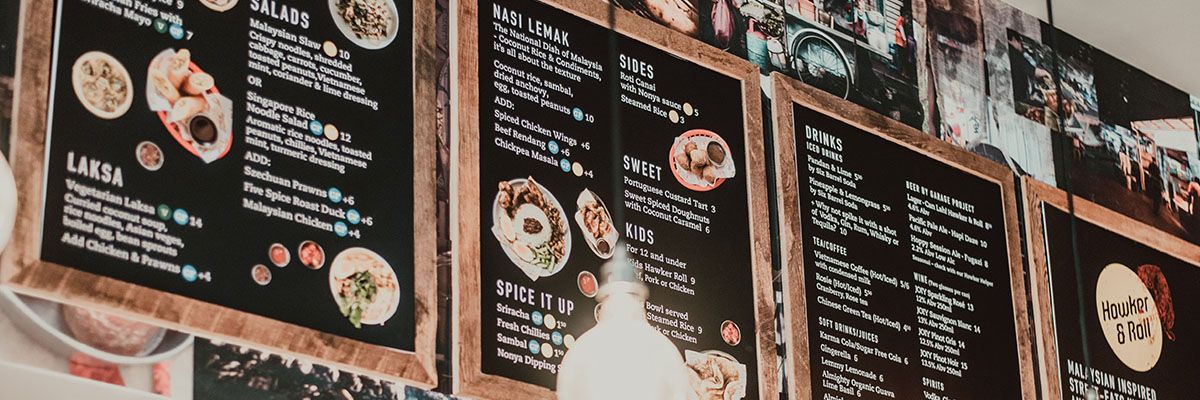People don’t just visit your restaurant website to see when you’re open or to learn about your story and team. They want to read your menu!

7 Tips for Designing a Mouth-Watering Menu
Robyn Rivera
How to design a mouth-watering menu for your restaurant website
#1. Do not use a PDF or image of your physical menu
In lieu of creating a separate page on their website for a menu, many restaurants make the mistake of using a PDF version of their physical menu. A quick and easy way to get your menu on your website it may be, but PDF menus are incredibly limiting.
For one, Google cannot crawl an image, and all of the potential keywords on your menu that your website could rank for will be hidden to Google. Having a text-based menu can help you rank higher on search engines.
Another reason not to use PDFs is that they can be problematic if you want to use QR code menus for your restaurant.
Last, but certainly not least, a PDF will be harder for mobile users to read. Since almost half of your restaurant’s website traffic will consist of mobile users, this can be a big problem.
#2. Showcase professional photos of your food
You’ll want to have great descriptions of each item on your menu that whets the appetites of your visitors, but before anyone reads a description, they’re going to look at the photos of your food.
People tend to eat with their eyes, which means that the visual appearance of a dish has a direct impact on how appetizing it looks to us. That’s why it’s important to have professional, high-quality photos of your food.
Food tends to deteriorate rapidly, which is why food photography can be tricky. If you can, it’s always a good idea to hire a professional photographer to capture your food in the best way possible.
#3. Keep it simple
The menu on your website should follow a lot of the same rules as your physical menu. You want to highlight your best-selling menu items and you want the layout to be easy to read and simple.
Don’t try to reinvent the wheel when it comes to your online menu. Keep it simple. Use plenty of white space around each item, and keep your menu organized into meals and categories.
A simple, clean menu design looks more modern and professional. Plus, if you overcrowd your menu with too many items or images, it’ll be harder for mobile users to use. Keeping it simple will help you provide a better experience for all of your visitors.
#4. Don’t forget about branding
No matter what page of your website someone lands on, you want them to instantly be able to tell that it’s your website, and your menu is no exception. This is accomplished through branding.
Your brand is more than just your logo. It’s the colors associated with your brand, the text sizes and fonts you choose, the type of photography you use, etc. And, all of this needs to be consistent on your menu.
Every aspect of your menu, from the way that you describe your food to the design of your menu, needs to reflect your branding. Before anyone even sees your restaurant’s name, there should be no question that the menu belongs to you.
#5. Make it easy to navigate
There are two different kinds of customers who look at a restaurant’s menu. There are customers who are just browsing to see what you have to offer, and there are customers who have something specific in mind.
Whatever type of customers are looking at your menu, you want to make it easy for them to find exactly what they’re looking for.
Make your menu easy to navigate by keeping it organized, just like you would with your physical menu. For example, if you offer more than one meal (breakfast, lunch or dinner), separate your menu by mealtimes.
#6. Write short and sweet descriptions
For your visitors, the most important aspect of an online menu is probably the images. But, a great description can also go a long way to push someone to place an online order or schedule a reservation.
Not only are menu descriptions important for your visitors, but they are also important for your organic rankings on Google. Your descriptions give you an opportunity to use relevant keywords that will help you drive organic traffic to your website.
Keep your descriptions short and sweet, and don’t get too lost in the weeds of trying to use keywords. Keywords should only ever be used naturally. If you have to force them into your descriptions, they’re probably not good keywords to target.
#7. Optimize your menu to drive sales
You don’t want a visitor just to read your menu. You want them to place an order or schedule a reservation.
Whether someone orders an entree or they order an entree, an appetizer and a dessert often depends on how your menu is designed. A part of designing an effective online menu is learning how to optimize it for sales.
Using different colors to highlight popular items, cross-promoting complementary pairings, upselling menu modifiers, promoting special offers and using relative pricing can all lead to an increase in sales.
Your online menu needs to have a great restaurant website to live on. Build yours with the Websites 360® restaurant website builder today.
